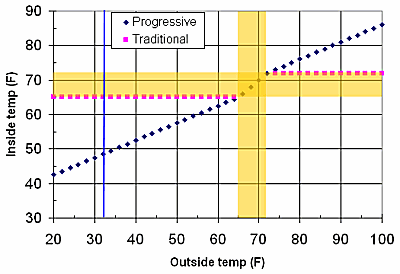“Progressive” thermostats to save energy
Sitting in my cold, air-conditioned classroom the last week, while it was 85-95ºF outside, a design for a new thermostat came to me. Currently, thermostats cool (or heat) a building to a desired temperature. My new design would create a floating target temperature, that moves up and down as the outside temperature changes. The goal would be to target a temperature that is half-way between the “comfort zone” (generally 65-72ºF) and the outside temperature.
For example, if the temperature outside is 92ºF and the comfort zone max is 72ºF, the air conditioning would be set to 82ºF.
An example of a cold day: If the temperature outside is 45ºF, and the comfort zone minimum is 65ºF, the heater would be set to 55ºF.

What’s the advantage?
Physics principles state that the greater the temperature difference between two bodies, the faster the heat is transferred between them. Thus, if the outside temperature is 92ºF, it takes less energy to cool a house from 92ºF to 82ºF than to cool it the next 10ºF, from 82ºF to 72ºF. And since hotter and colder days place higher demands out our electrical grid (especially hot days), these are the days where we need to save energy the most.
Other adjustments/design alternatives
- This new design could allow for adjusting the percent difference for hot and cold days individually. For example, if a person can handle heat better than cold, s/he might change hot days to only 25% of the way from the outside temperature to the comfort zone (using the previous example, cooling the house to 87ºF), but on cold days s/he would set it to 75% (the example above heat to 60ºF).
- The thermostat could easily be designed to have a maximum hot temperature allowed (e.g. never over 82ºF) and/or a minimum cold temperature (e.g. 50ºF). This would be useful in extremely hot or cold climates.
With wireless technology as simple and inexpensive as it is these days, it would be easy to place the outside temperature sensor in an appropriate location, not necessarily right outside the thermostat.
Questions/comments
Please leave your comments below. I’d love to hear what others feel about this idea.





Lee-
This is an excellent idea!
I bet most houses in the US are still using a bimetallic strip as a physical on-off switch for temperature control. We have a programmable thermostat, but (a) it loses its programming if the battery dies and (b) it makes no adjustment for outside temperature or for the times we actually leave the house and return, which are often different from the ones we programmed.
A possible refinements, though perhaps a bit Orwellian: If the owner insists on a temperature too different from that outside, the utility company charges them more for gas or electricity.
Lee, Certainly for heating systems something like this is already being done. I live in a continental climate, i.e. one of extremes. I live in Minnesota. All my thermostats, one per zone (per floor in my home) “anticipate,” i.e. they turn on or off a half a degree or so before the desired temp is reached. The hot water heating system indeed already has an outdoor temperature sensor and it heats the water appropriately… it keeps the indoor thermal mass appropriate to counter the outside temp, so when it’s -20F outside, the boiler is heating water to 150+. But when it’s just 45F outside it only heats the water to 110 or so. I’m not sure of the exact numbers but the temp curves are calculated based on size of the building, water volume etc. etc.
My electric company has a program where I, the homeowner, am given an overall discount if I let them cycle my a/c on and off, leaving just the fan going, during peak power times. This allows them to prevent brownouts and to better balance their grid.